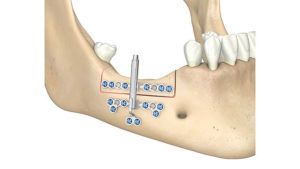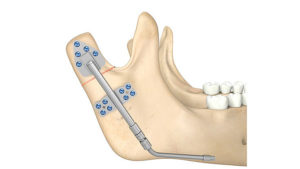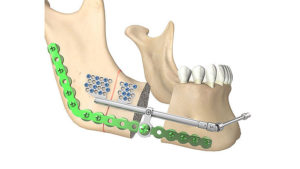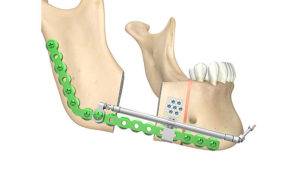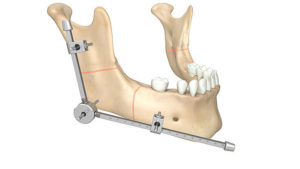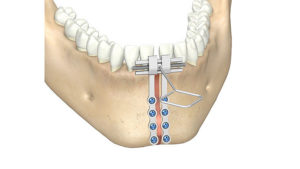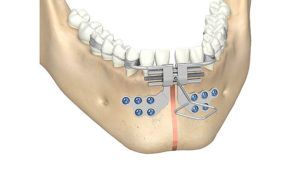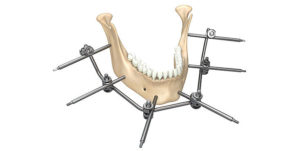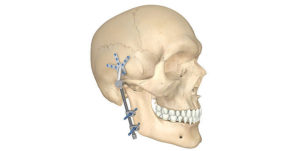Mandible Distraction
The different anatomical forms of mandibular microsomias and asymmetries frequently make high demands on the variability and adaptability of the distractors used. Prefabricated distractor models are sometimes too static and therefore cannot meet the requirements of specific clinical tasks. The Zurich mandibular distractors are suitable for distraction of the ascending mandibular ramus as well as of the mandibular body in infants and young adults in case of congenital or acquired mandibular defects and hypoplasia.
The Zurich II concept is suitable for similar indications but takes a completely different path: it is totally based on a modular principle, breaking down intraoral distractors into their basic components. All system components can be easily and rapidly combined with each other to create a perfect whole.
Additionally, transport distraction represents an interesting therapeutic option for patients with mandibular continuity defects as a result of trauma or resection or defects from malignant tumors after radiation and hyperbaric oxygen therapy.
For in-depth information, documentation, key publications and specifications, head to the KLS Martin website here.
To chat with one of our team, or ask us a question, please get in touch. Call us on 0800 333 909 or email admin@orthomedics.co.nz.
Devices for Distraction of the Alveolar Ridge
TRACK Distractors
Indications:
- Partial defects of the mandibular and maxillar alveolar crest
- Periodontal diseases with severe localized bone loss
- Localized atrophy of the alveolar crest
Features:
- Distraction length: 12 mm, 15 mm
- Distraction length/turn: 0.3 mm, 0.5 mm
- To be fixed with 1.0 mm / 1.5 mm Screws
Benefits:
- Available in different designs to treat all kind of alveolar defects
- Vector stabilizing plate to prevent tilting of the distractor body
Devices for use in Correction of Mandibular Malformations
Zurich II Distractors
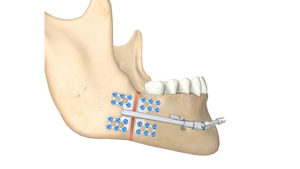
Indications:
The Zurich II Distractor (for infant patients below an age of 12 months the Zurich Micro II Distractor) is intended for distraction in cases of:
- congenital malformation
- acquired mandibular hypoplasia
Features:
- Distraction length: 15 mm, 20 mm, 25 mm, 30 mm
- Distraction length/turn: 0.3 mm, 0.5 mm, 0.6 mm
- To be fixed with 1.0 mm / 1.5 mm Screws
Benefits:
- Symmetrical design, usable on patient´s right and left side
- Anti-relapse ratchet prevents backward rotation
- Flexible activator concept
Zurich Paediatric Ramus Distractors
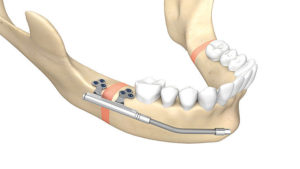
Indications:
The Zurich Mandibula Distractor is suitable for distraction of the ascending mandibular ramus as well as of the mandibular body in infants and young adults in case of congenital or acquired mandibular defects and hypoplasia.
Features:
- Distraction length: 15 mm, 20 mm, 25 mm
- Distraction length/turn: 0.5 mm
- To be fixed with 1.5 mm Screws
Benefits:
- Available in different activator designs
Horizontal Distractors
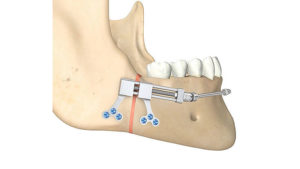
Indications:
The Horizontal Distractor is suitable for mandibular distraction in cases where gradual bone lengthening is required, especially as a result of:
- congenital malformation or deformation
- acquired hypoplasia
Features:
- Distraction length: 10 mm, 15 mm, 20 mm
- Distraction length/turn: 0.5 mm
- To be fixed with 1.5 mm Screws
Benefits:
- Low-profile distractors
- Usable on patient´s right and left side
Ramus Distractors
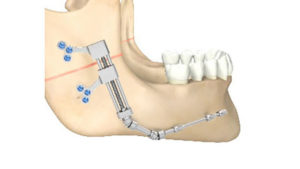
Indications:
The ramus distractor is intended for the distraction of the ascending mandibular branch where gradual bone lengthening is necessary, especially due to:
- congenital malformation or deformation
- acquired hypoplasia
Features:
- Distraction length: 15 mm, 20 mm, 25 mm
- Distraction length/turn: 0.5 mm
- To be fixed with 1.5 mm Screws
Benefits:
- Low-profile distractors
- Usable on patient´s right and left side
Mandibular Telescoping Distractors
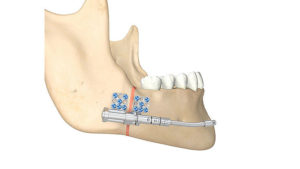
Indications:
The Mandibular Telescoping Distractor is suitable for distracting the lateral mandibular body in cases where gradual bone lengthening is required, especially for correction of congenital or acquired malformation and hypoplasia.
Features:
- Distraction length: 20 mm, 30 mm
- Distraction length/turn: 0.35 mm
- To be fixed with 1.5 mm Screws
Benefits:
- The design allows maximum distraction length with minimum initial space requirements, as the distractor achieves its full extent only at the end of the distraction phase
- Symmetrical design, usable on patient´s right and left side
- Flexible activator concept
Right Angle Driven (RAD) Distractors
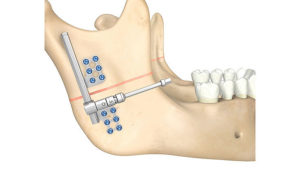
Indications:
- Reconstruction of the mandibular ramus
- Congenital malformation
- Acquired mandibular hypoplasi
Features:
- Distraction length: 20 mm, 25 mm
- Distraction length/turn: 0.1 mm
- To be fixed with 1.5 mm Screw
Benefits:
- Due to the offset activator providing 90-degree access, intraoral activation is facilitated
- Symmetrical design, usable on patient´s right and left side
- Flexible activator concept
Zurich Wood Distractors
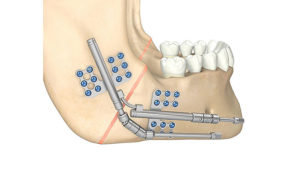
Indications:
The Wood Distractor is an intraoral, bidirectional device for the simultaneous lengthening of the ascending ramus and horizontal mandibular body
Features:
- Distraction length: 20 x 20 mm
- Distraction length/turn: 0.5 mm
- To be fixed with 1.5 mm Screws
Benefits:
- Enables a bi-directional distraction
- Symmetrical design, usable on patient´s right and left side
- Flexible activator concept
Zurich Bidirectional Distractors
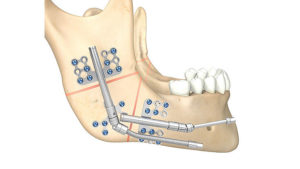
Indications:
The Zurich Bidirectional Distractor is an intraoral, bidirectional device for the simultaneous lengthening of the ascending ramus and horizontal mandibular body
Features:
- Distraction length: 15 x 20 mm
- Distraction length/turn: 0.5 mm
- To be fixed with 1.5 mm Screws
Benefits:
- Enables a bi-directional distraction
- Symmetrical design, usable on patient´s right and left side
- Flexible activator concept
Devices for Transport Distraction of the Condylar Head
Ramus Transport Distractors
Indications:
- Reconstruction of the mandibular condyle
- Congenital malformation
- Acquired mandibular hypoplasia
Features:
- Distraction length: 20 mm, 25 mm, 30 mm
- Distraction length/turn: 0.5 mm
- To be fixed with 1.5 mm Screws
Benefits:
- Symmetrical design, usable on patient´s right and left side
- Flexible activator concept
- A special retention plate is optionally available for increased patient convenience during the consolidation phase
Devices for Mandibular Transport Distraction
Threadlock Transport Distractors
Indications:
The ThreadLock transport distractor is an intraoral system which allows segment transport, enabling reconstruction of continuity defects in the mandible.
The distraction system is indicated for the following defects:
- Mandibular continuity defects caused by trauma or resection
- Mandibular defects caused by tumors (after hyperbaric oxygen therapy and completed radiation)
Features:
- Distraction length: 50 mm
- Distraction length/turn: 0.5 mm
- To be fixed with 1.5 mm Screws
Benefits:
- Enables reconstruction of big defects
- Symmetrical design, usable on patient´s right and left side
- Flexible activator concept
Herford Transport Distractors
Indications:
The Herford transport distractor is an intraoral system which allows segment transport, enabling reconstruction of continuity defects in the mandible. Since the distractor has no fixed connection to the reconstruction plate it is particularly suitable for bone transports in a curved motion, but maximally up to the central line (symphysis).
The distraction system is indicated for the primary reconstruction of the following defects:
- Mandibular continuity defects caused by trauma or resection
- Mandibular defects caused by tumors (after hyperbaric oxygen therapy and completed radiation)
Features:
- Distraction length: 40 mm, 60 mm
- Distraction length/turn: 0.5 mm
- To be fixed with 1.5 mm Screws
Benefits:
- Enables reconstruction of big defects
- Symmetrical design, usable on patient´s right and left side
- Flexible activator concept
External Device for use in Correction of Mandibular Malformations
3D Xternal Distractor
Indications:
- Mandibular distraction osteogenesis in cases of congenital deficiencies, such as unilateral and lateral micrognathia
- Syndrome patients, such as Pierre Robin or Goldenhar cases
- Posttraumatic bone stabilization and bone lengthening
- Potential for external multi-vector transport distraction osteogenesis
Features:
- Distraction length: 35 mm, 50 mm, 65 mm
- Distraction length/turn: 0.5 mm
- To be fixed to the bone with pins
Benefits:
- Flexible and easy-to-adjust on all particular patient needs
- 3-dimensional manipulation of bone segments and multiple vector control at any moment
- Individual bone lengthening of the mandibular body and/or ramus with a single osteotomy
- Combination of light weight, low profile and highest stability
- Universal device can be used on patient’s left or right side
- Possibility to bridge and stabilize the distraction gap with a consolidation bar during consolidation period
Molina Distractors
Indications:
Molina distractors are used for treating congenital or acquired mandibular malformation, deficits and hypoplasia in cases where extraoral approach is required.
Unilateral Molina Distractor:
- Distraction of the ascending ramus of the mandible of babies, children and adults
- Distraction of the mandibular body of babies, children and adults
Bidirectional Molina Distractor:
- Simultaneous distraction of the ascending ramus and the mandibular body of children and adults
Features:
- Distraction length: 28 mm, 43 mm, 53 mm, 56 x 40 mm, 76 x 40 mm
- Distraction length/turn: 0.5 mm
- To be fixed to the bone with pins
Benefits:
- Color coded according to indication for use in babies/ children/ adults
- Bi-directional device available
Devices for Transversal Mandibular Distraction
Rotterdam Midline Distractors
Indications:
The Rotterdam Midline Distractor is to be used for distraction osteogenesis of the mandibular symphysis in cases of severe crowding of the mandibular region and transversal mandibular deficits.
Features:
- Distraction length: 15 mm
- Distraction length/activation of 90°: 0.25 mm
- To be fixed with 2.0 mm Screws
Benefits:
- Activating wire is included in set
Bologna Midline Distractors
Indications:
The Bologna Midline Distractor is to be used for distraction osteogenesis of the mandibular symphysis in cases of severe crowding of the mandibular region and transversal mandibular deficits
Features:
- Distraction length: 15 mm
- Distraction length/activation of 90°: 0.25 mm
- To be fixed with 2.0 mm Screws
Benefits:
- Activating wire is included in set
- The distractor offers the combination of bone-borne and tooth-borne anchorage. The attached steel bar enables a stable fixation with the dental anchoring and in this way allows a parallel bone and dental arch widening. Therefore a maximum reliability of force transmittance can be guaranteed.
Mandible External Fixation System
X-Fix
Indications:
The X-Fix external fixator is intended to stabilize the mandible in selected clinical situations:
- Mandibular fractures
- Mandibular fractures associated with infections
- Severe comminuted fractures of the mandible
- Healing problems / non-unions
- Tumor resections
- Bullet injuries
- Fractures with severe soft-tissue impairment
- Fractures in radiation patients
- Panfacial fractures
- Burns
- Bone defects with bone grafts
Features:
- Can be assembled in two unique configurations
- To be fixed to the bone with pins
Benefits:
- Allows a simple, quick, and atraumatic handling
- Pins available in different diameters and different thread lengths for a strong and stable fixation as well as an accommodation to various soft and bone thicknesses
- Different rod designs allow best possible choice for each type of mandible fracture or defect
- Anatomically pre-bent rods for best possible average fit
Cranio Mandibular Fixator according to Matthews
Indications:
- Occesous ankylosis unilaterally or bilaterally
- Intracapsular comminuted fracture and concurrent: posterior malocclusion that prevents use of a splint against an open bite; severe cranial trauma (patient not responsive, persistent coma)
Features:
- Available in three sizes: small, normal, long
- The articulating arm is fixed to the mandibular bone with pins
- The temporal stabilizing plate is fixed with 2.0 mm Screws
Benefits:
- With the fixator intercapsular space is created and maintained
- Facilitates the subsequent mobilization of the mandible
- Re-ankylosis is intended to be avoided, and healing of the fracture supported
